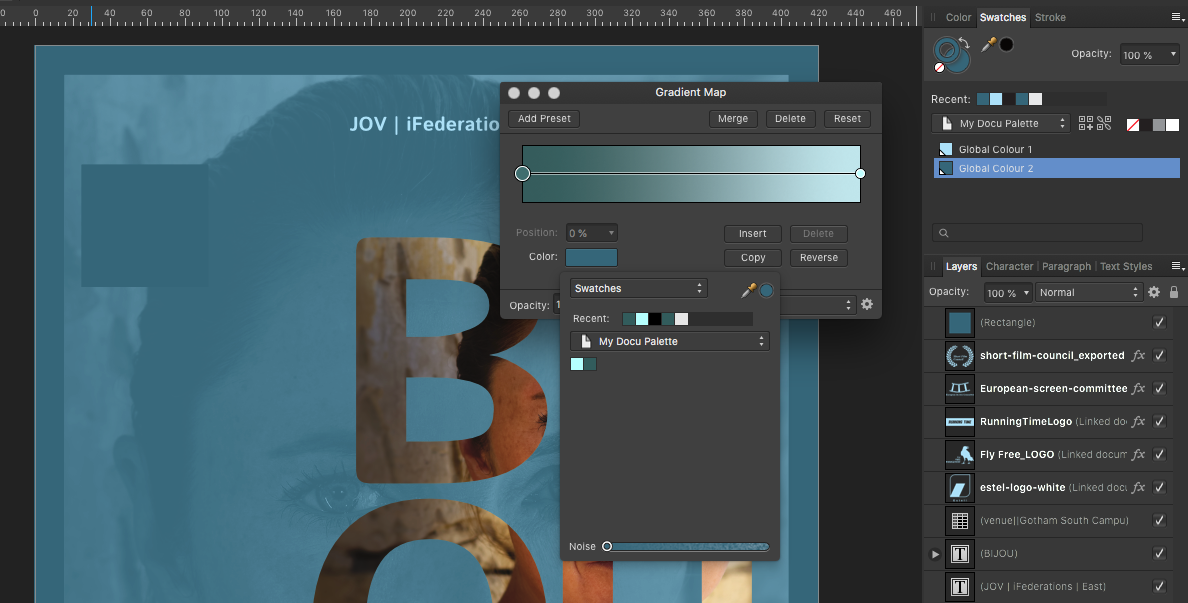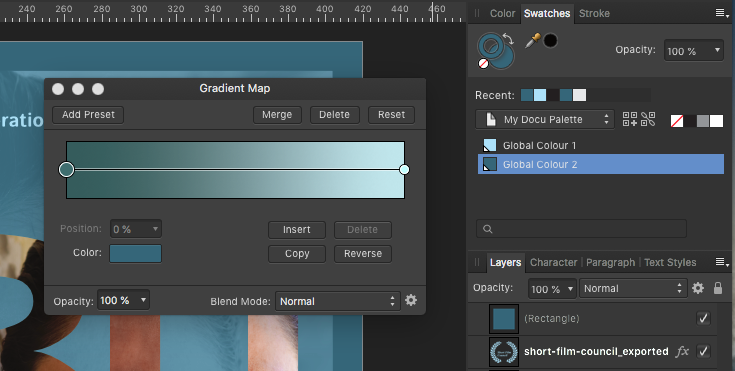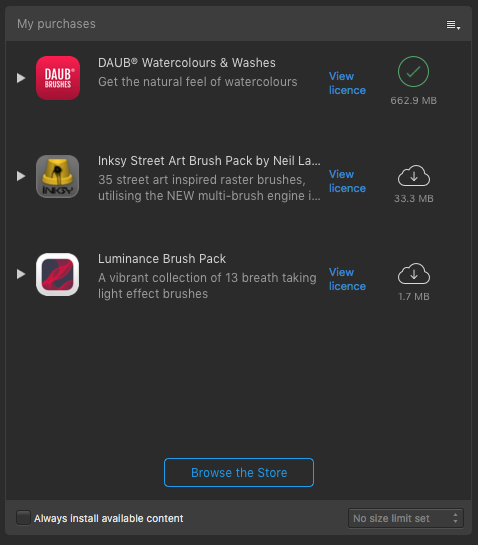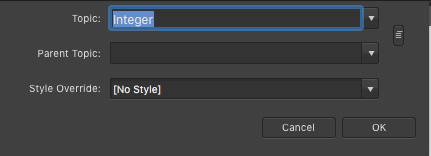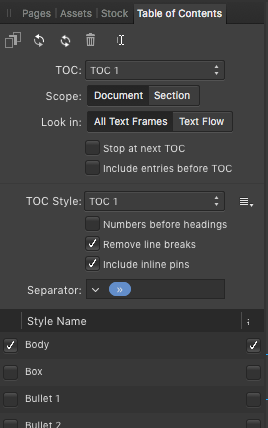
Mark Oehlschlager
Members-
Posts
644 -
Joined
-
Last visited
Everything posted by Mark Oehlschlager
-
Color Swatch Bugs (APub 1.8.6 and 1.9.0.874)
Mark Oehlschlager replied to Mark Oehlschlager's topic in V1 Bugs found on macOS
This remains a problem in Beta 1.9.0.887. -
I just tried exporting an Affinity Designer document with a two-word headline to PDF, EPS, and SVG. In my experience, the SVG preserved the text as editable line text in Adobe Illustrator. The EPS file converted the text to outlines. Illustrator had difficulty interpreting the exported PDF – it converted one word to outlines, but preserved the second word as editable line text. I recommend exporting your Affinity files as SVG files, and make sure that your export settings do *not* include the option to convert text to outlines. Beyond that, I can only recommend that you export all of your Affinity Designer files out as both PDF and SVG, and be prepared to reset the text in Illustrator if necessary – a minor inconvenience.
-
I was just working through the poster exercise in the new Publisher Workbook, and I discovered bugs in the display and behavior of global color swatches. Missing Swatch Symbols. In contextual color panels, the global, overprint and spot color symbols do NOT appear with color swatches. Color Shift in Adjustment Layer Windows. The appearance of defined global colors is different when applied to a stop in a Gradient Map adjustment layer, although the appearance of the global color is correct in the art on canvass. Edited Global Swatches Don't Update in Adjustment Layers. When a global color is edited, the color change is reflected in the global color swatch, and in vector shapes to which the global color has been applied. However, color stops in Gradient Map adjustment layers, to which a global color has been assigned, do not update after the global color stop has been edited. Instead, one must manually reassign the changed global color to the color stop.
-
IDML export
Mark Oehlschlager replied to PaoloT's topic in Feedback for Affinity Publisher V1 on Desktop
@Wosven All very practical and unimpeachable advice: 1)Recognize that InDesign is an industry standard, reinforced by the large investments so many institutions have made in supporting archival and storage systems; and 2) Remember, before designing and building any project, make sure you know what the deliverable requirements are, including file type. But then comes the inevitable depressing feeling of defeat and sense of imprisonment: pay for and use InDesign, whether you like it or not. Having the world agree on open exchange file formats for all kinds of work would empower end-users to pick their tools of choice, and would encourage more competition in the app development space. But this would be a pipe dream, it seems. Consider the example of Microsoft Office. I think the Microsoft Office suite is absolute shit from a UX point of view, but it's ubiquity and default status as an industry standard means everyone must adopt it, and discount competing productivity suites, even if the alternative is a better piece of software. Not sure what this means for the Affinity Suite. Maybe doomed to a niche market. -
IDML export
Mark Oehlschlager replied to PaoloT's topic in Feedback for Affinity Publisher V1 on Desktop
@MikeW Not intending to argue a point. Rather, participating in the discussion and exploring practical routes to a solution. Bottom line is pretty clear here: @Designer1 is better off subscribing to Adobe InDesign, as that is the file format his publisher demands. Neither Serif nor Markzware offers him much relief. Maybe, some years from now, there will be other alternatives for him. -
IDML export
Mark Oehlschlager replied to PaoloT's topic in Feedback for Affinity Publisher V1 on Desktop
@Designer1 If that's the most economical way out of this problem you have (as opposed to purchasing the PDF2DTP license), do what you must. I'm not sure why the publisher demands INDD files and refuses PDF files. But if you are wedded to this publisher, you have no choice but to either subscribe to Adobe InDesign, or to purchase the Markzware PDF2DTP license. To my knowledge, Markzware does not yet make a Publisher 2 IDML or INDD conversion app. -
IDML export
Mark Oehlschlager replied to PaoloT's topic in Feedback for Affinity Publisher V1 on Desktop
@Designer1 Sorry to hear of your predicament. Certainly it would be welcome for Serif to implement an IDML export. It would knock down another barrier to entry for prospective customers of the Affinity Suite. Hopefully that capability will come. In the meantime, I can't imagine that recreating your documents from scratch is a feasible solution. If the printer will not accept a PDF-x document, I can't see a way out of your predicament without purchasing the PDF2DTP application from Markzware to convert to INDD. Moreover, compounding your pain, to be completely confident in the conversion, you would have to subscribe to InDesign for a month in order to check that the INDD conversion is 100% faithful. I sympathize. Must be a painful position to be in. Good luck. -
UI Error in TOC Panel (Publisher 1.8.6)
Mark Oehlschlager replied to Mark Oehlschlager's topic in V1 Bugs found on macOS
@Gabe Yes, the burger menu works for me. Equally, removing the column heading that had been truncated in 1.8.6 helps to eliminate the worry that something's gone wrong or is missing. -
I'm setting up a Publisher document for a book that is structured in Parts and Chapters. The interior design is such that the part titles appear as running heads on the verso pages, and the chapter titles appear as running heads on the recto pages. The question is this: what is the best way to set this up with master pages in Publisher? One solution I have considered is to create separate master page spreads for each book Part, where the part title is set manually on the master verso page, and the chapter title is set as a dynamic section field on the master recto page. In that case, I would use the Section Manager to create sections for each chapter in the book, supplying the chapter title to the Section Name field in the Section Manager. The above solution can be made to work, but is there a way to create a user defined field for the Part title? If so, I wouldn't have to create separate master page spreads for each book Part. I could just insert my custom Part Title field on the verso page of a single master page spread.
-
Guide Colors?
Mark Oehlschlager replied to handshaper's topic in Feedback for Affinity Publisher V1 on Desktop
@MEB I would like to bump this topic up. Presently laying out a document in Publisher, where the color of the page ground is very close in color and value to the default cyan color of the guidelines. As a result, it's nearly impossible to see the guides. It would be good if one could change the color of guides to contrast with the content of any document. -
I've got Publisher 1.8.6 installed on my iMac running High Sierra 10.13.6, and I've found that there is a UI glitch in the TOC panel. The column heading over the checkboxes for page number occurrences of specific paragraph styles is severely cropped/truncated and cannot be read. (See attached image.)
-
I've read through the Help File page on creating and styling a TOC in Publisher. I've also watched the video tutorial. Still, I find the information to be incomplete. Please revisit the Help Files and the video tutorials to clarify how one is to make use of and manage the special TOC paragraph and character styles (e.g., how one goes about applying one style to a chapter title, and another to the corresponding page number), and to demonstrate how one can build TOC's for publications that do have more than one TOC. It's very frustrating to receive just half of the information required to understand the feature completely.
-
@garrettm30 Thank you for that link. That's definitely a start. Even this video doesn't explain everything, and the presenter seems a bit unsure about what everything does. Through trial and error, I believe I've discovered that the "Tabstop" field in the B&N sub-panel controls any tab inserted between a bullet or number and the following text. This is unrelated to the settings in the Tab Spaces and the Spacing sub panels. I still have no idea what the left-, center-, and right-alignment buttons control. Proper use of the "Level" field needs to be demonstrated. It's not clear. A fuller explanation for the "Restart numbering" needs to be presented. It's not clear. The "Restart numbering now" check box needs an explanation. The "Name" field and the "Global" check box need an explanation. It's not clear what these are for, nor how to use them. Through trial and error, I discovered that the "Style" popup menu is meant to apply Character Styles to the numbers itemizing a numbered list. I still don't understand how one would go about setting up coordinated/linked paragraph styles for multi-level lists. A fuller explanation of all of this in either the Help files or subsequent tutorial videos is needed.
-
I have read through both help file pages on Bullets and Numbering very carefully, and I must say that the information is incomplete and unclear. Please review these Help file pages from the perspective of a new user and rewrite the instructions with illustrations for absolute clarity. It would also be worthwhile to add a tutorial video demonstrating how to use and configure custom Bullets and Numbering styles and settings.
-
@Sean P FYI, the zoom behaviors of the Zoom and View tools remain broken in 1.8.6 across the suite of apps. Double clicking Zoom tool does zoom documents to 100%, but ... Double clicking the View tool does not zoom documents to "Fit". Zoom levels are not synchronized between the Zoom tool, View tool, and the Zoom pop-up menu and slider in the context toolbar. Giving this thread a "bump" as you had requested before.
-
Discussion on Affinity Suite for macOS 1.8.6 release
Mark Oehlschlager replied to Oval's topic in News and Information
@Bryan Rieger Maybe, but for reasons beyond the control of Serif. A lot of users feel trapped and fearful of moving on. It's a psychological trap. -
Discussion on Affinity Suite for macOS 1.8.6 release
Mark Oehlschlager replied to Oval's topic in News and Information
@Patrick Connor The network effect advantages that Adobe enjoys is a powerful enemy to challengers. In spite of all the resentment felt toward Adobe, for the subscription model and other reasons, fear of dropping out of the professional network as a result of dropping Adobe has end users behaving like a bunch of heroin addicts. -
I would like to request an update to the "New Master Page" and "Spread Properties" dialogue box to include a "Based on ..." attribute so that the parent-child relationship of child master pages can be more explicitly defined and redefined in these dialogue boxes. Presently, one right-clicks on a child master to select "Apply Master ..." to configure a parent-child relationship. And the only indication of this linkage occurs if one hovers the cursor over the child master to reveal a tool-tip message. It would be better to add a "Based on ..." attribute field to the "New Master Page" and "Spread Properties" dialogue box, just as one can set up parent-child paragraph styles. Thank you for your consideration.

